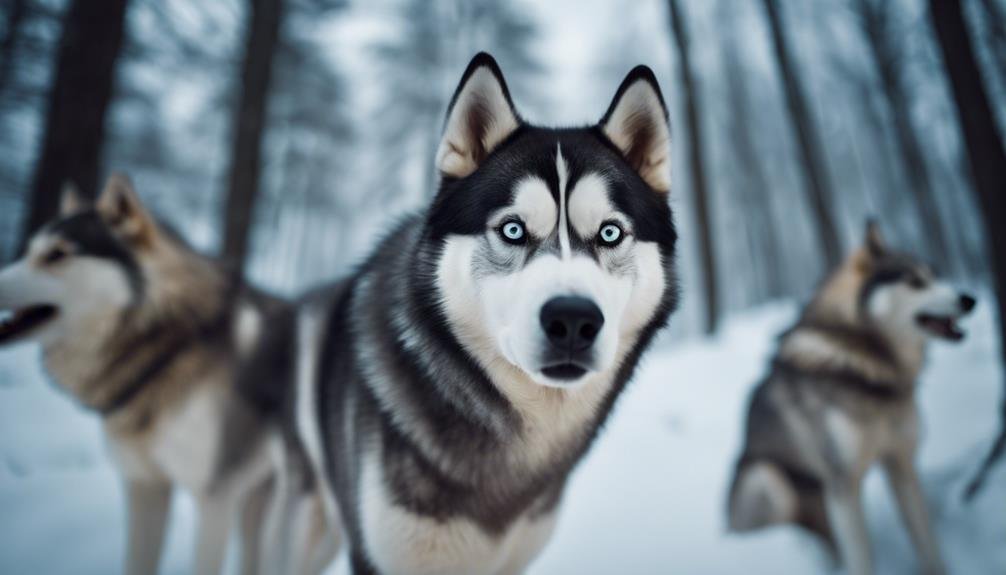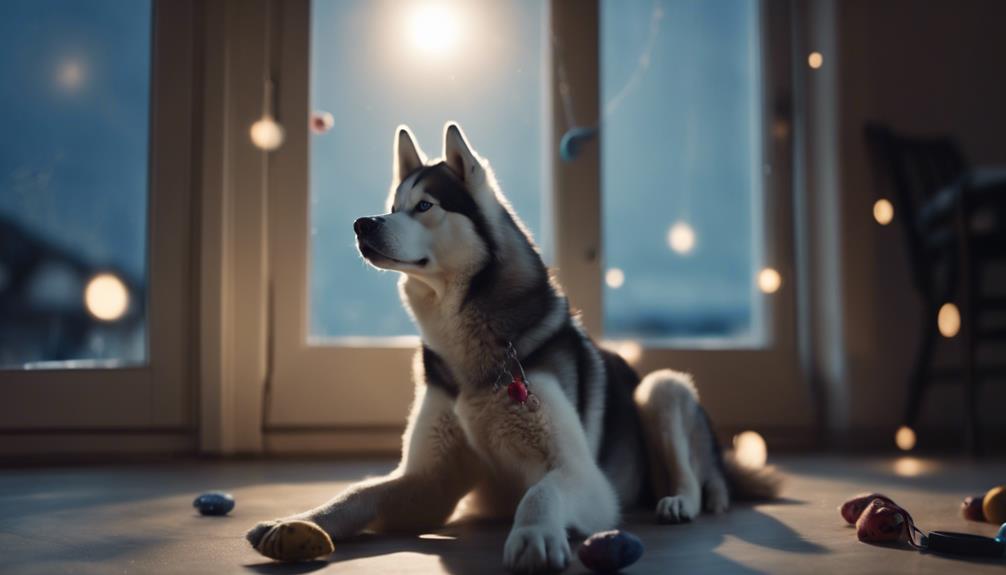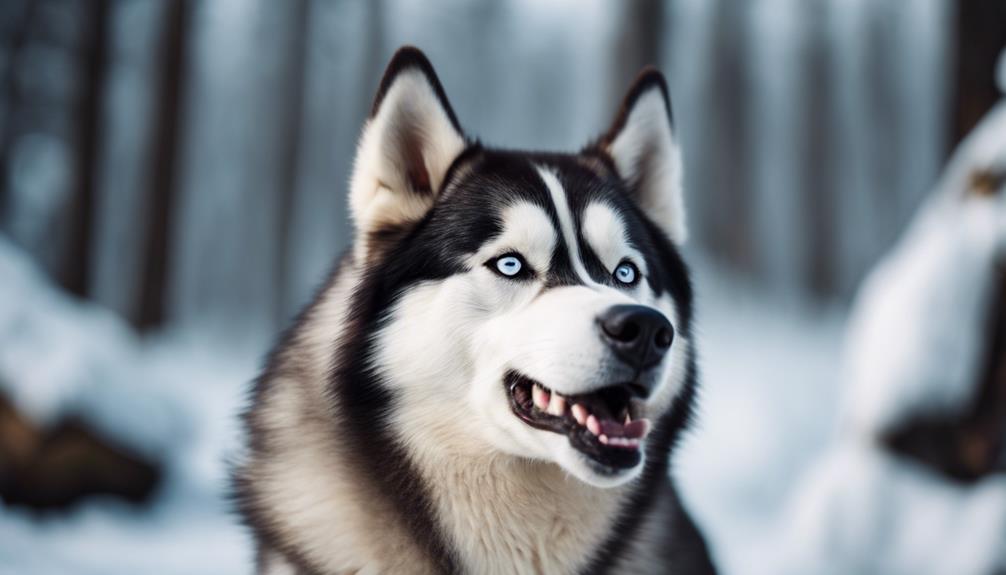The enigmatic vocalizations of Huskies have long puzzled and intrigued pet owners worldwide. Beyond mere noise-making, these spirited canines use howls, screams, and sassy back talk as intricate forms of expression.
Delving into the reasons behind these behaviors unveils a world of communication deeply rooted in Huskies' genetic makeup and social interactions. From emotional cues to playful banter, each vocalization holds a key to deciphering the complex language of these majestic companions.
Understanding the motives behind Huskies' vocalizations offers a glimpse into their inner world and strengthens the bond between humans and these enigmatic creatures.
Key Takeaways
- Huskies scream, howl, and sass to communicate emotions and needs effectively.
- Their vocalizations reflect ancestral traits and pack-oriented nature.
- Understanding huskies' vocal cues and behaviors is essential for building a strong bond.
- Providing mental and physical stimulation helps prevent boredom and undesirable behaviors.
Huskies' Vocalizations: A Form of Communication
Huskies' vocalizations serve as a primary form of communication within their packs, conveying a range of emotions, needs, and social cues. These expressive sounds enable Huskies to convey messages to other dogs, alerting them to various situations and establishing social hierarchies.
Whether it's a howl of excitement during playtime, a bark to signal danger, or a whine to express discomfort, Huskies utilize their vocal prowess to interact with their environment. Through these vocalizations, they can also seek attention, initiate play, or communicate their desires effectively.
Understanding the nuances of Huskies' vocalizations is crucial for building strong bonds with these intelligent and vocal breeds, enhancing communication and mutual understanding within the human-canine relationship.
Emotional Expression Through Howling
Within the realm of canine communication, the act of howling serves as a poignant avenue for huskies to express their deepest emotions and innermost feelings.
When huskies howl, they convey a range of emotions such as loneliness, anxiety, and even joy. The haunting sound of a husky's howl can indicate a sense of longing or a need for companionship, reflecting their pack-oriented nature.
Additionally, howling can serve as a form of release for huskies experiencing frustration or discomfort, allowing them to vocalize their emotions in a raw and instinctual manner.
Responding to External Stimuli

When confronted with external stimuli, huskies exhibit varied and distinct responses that shed light on their sensory perception and behavioral adaptability.
Huskies are known to howl in response to sirens, high-pitched sounds, or certain types of music. This behavior stems from their keen sense of hearing, reminiscent of their ancestral ties to wolves.
Additionally, huskies may vocalize in reaction to unfamiliar noises or changes in their environment, serving as a form of alertness or communication.
Their sensitivity to external stimuli showcases their alert nature and ability to adapt to different situations. Understanding how huskies respond to external triggers can aid in creating a supportive and enriching environment for these vocal and expressive dogs.
Seeking Attention and Playtime
Seeking attention and playtime is a common behavioral trait observed in Huskies, reflecting their sociable and energetic nature. When Huskies engage in attention-seeking behaviors, they are often craving interaction and fun activities. This desire for playtime can manifest in various ways, such as:
- Bringing toys or treats to their owners
- Nudging or pawing at their owners
- Running around excitedly or performing playful antics
- Initiating games like tug-of-war or fetch
Understanding and responding to these cues positively can strengthen the bond between owners and their Huskies, fulfilling the dogs' need for socialization and activity.
Ancestral Influence on Husky Behavior

The behavior of Huskies is significantly influenced by their ancestral ties to wolves, shaping various aspects of their communication and social interactions. This ancestral connection plays a crucial role in understanding why Huskies exhibit certain behaviors such as howling, pack dynamics, and territorial instincts. Here is a breakdown of how ancestral influence affects Husky behavior:
| Aspect | Influence |
|---|---|
| Communication Style | Howling, barking, and body language mimicry |
| Social Hierarchy | Pack mentality, alpha roles |
| Hunting Instincts | Chasing small animals or objects |
| Territorial Behavior | Marking boundaries and defending space |
| Vocalization Patterns | Expressing needs, emotions, and warnings |
Understanding Howling as Communication
One of the key aspects of deciphering Husky behavior lies in understanding howling as a form of communication within their pack structure. Howling serves as a vital means for Huskies to convey messages and emotions to their pack members and human companions.
To grasp the significance of howling in Huskies, consider the following points:
- Establishing Territory: Huskies howl to define and defend their territories.
- Expressing Emotions: Howling can signify excitement, anxiety, or distress.
- Signaling Location: Huskies howl to communicate their whereabouts to pack members.
- Calling for Attention: Howling may be a way for Huskies to seek attention or interaction.
Understanding these aspects of howling can provide insights into the complex communication dynamics of Huskies.
Loneliness and Separation Anxiety

Understanding how Huskies' howling can indicate loneliness and separation anxiety sheds light on their emotional well-being in domestic settings.
Huskies are social animals that thrive on companionship and can feel distressed when left alone for extended periods. Excessive howling, whining, or destructive behavior when separated from their owners are common signs of separation anxiety in Huskies.
This emotional response is rooted in their pack-oriented nature, where being alone may trigger feelings of isolation and distress. Addressing separation anxiety requires establishing a routine, providing interactive toys, and gradually desensitizing the Husky to being alone.
Creating a secure and comforting environment can help alleviate their loneliness and strengthen the bond between the Husky and their owner.
Huskies' Vocal Reactions to Sounds
When exposed to various sounds, Huskies exhibit diverse vocal reactions that convey their responses and emotions. These reactions can range from howling to playful barking, each serving as a form of communication or expression.
To paint a clearer picture, consider the following scenarios:
- Howling in Response to Sirens: Huskies may howl in response to sirens, mimicking the sound or joining in.
- Excited Barking for Playtime: When eager for play, Huskies may bark with excitement, signaling their readiness.
- Whining in Discomfort: In uncomfortable situations, Huskies may whine to express their unease.
- Growling as a Warning: When feeling threatened, Huskies may growl as a warning to others.
Addressing Sassy Back Talk

Addressing the sassy back talk exhibited by Huskies requires consistent training and clear communication to establish boundaries and reinforce desired behaviors. When Huskies engage in sassy back talk, it is essential to address it promptly to prevent it from becoming a persistent habit. Here is a table highlighting effective strategies to tackle sassy back talk in Huskies:
| Strategies to Address Sassy Back Talk | Description | Implementation |
|---|---|---|
| Positive Reinforcement | Rewarding desired behaviors with treats or praise | Use treats and praise immediately after desired behavior |
| Firm and Calm Commands | Issuing commands in a confident and composed manner | Avoid yelling or showing frustration |
| Consistent Training | Establishing a routine and sticking to it | Practice commands daily and maintain consistency |
Building Communication and Bond With Huskies
To cultivate a strong bond and effective communication with Huskies, consistent and empathetic interaction is paramount. Understanding their vocalizations and behaviors is crucial in building a harmonious relationship.
Here are some tips to help you connect with your Husky:
- Spend quality time engaging in activities they enjoy, such as running or playing outdoors.
- Use positive reinforcement techniques like treats and praise to reinforce good behavior.
- Pay attention to their body language and vocal cues to better interpret their needs and emotions.
- Establish a routine to create a sense of security and predictability for your Husky.
Is Sassy Back Talk from Huskies a Sign of Fear or Anxiety?
When considering dogs scared of thunder reasons, sassy back talk from huskies may actually indicate fear or anxiety. Instead of being confident or sassy, they may be showing signs of distress. It’s important to address the root cause of this behavior and provide a comforting environment for your pet.
Conclusion
In conclusion, understanding the vocal behaviors of Huskies as a form of communication rooted in their ancestral ties and individual personalities is key to fostering a deeper connection with these spirited companions.
By deciphering the meanings behind their howls, screams, and sassy back talk, pet owners can address their emotional needs, social dynamics, and territorial instincts.
Embracing Huskies' unique communication style through physical exercise, mental stimulation, and behavioral training can lead to a stronger bond between humans and their canine companions.




